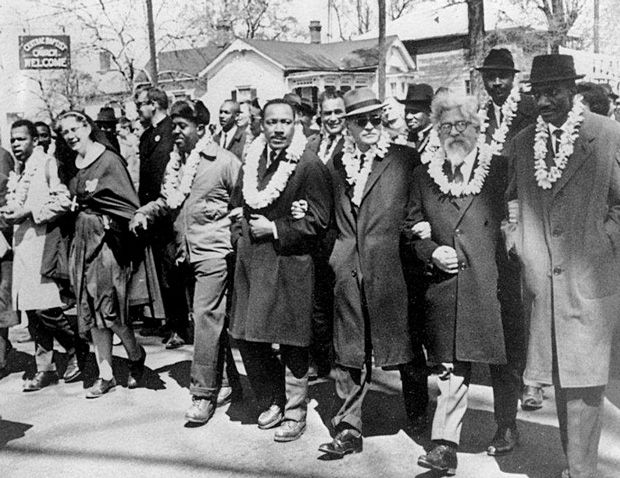Remembering St. Louis Jews who marched with Martin Luther King
Published February 12, 2015
Amid all of the buzz regarding the film “Selma,” it is appropriate to reflect on the actual events surrounding the historic 1965 voting rights marches led by the Rev. Martin Luther King Jr. from Selma to Montgomery, Ala., which are dramatized in the flawed but powerful movie.
While the movie gets much of the story right, the film has received a chorus of criticism from historians and Lyndon B. Johnson loyalists who complain that the screenplay makes Johnson look like a clumsy buffoon who tried to thwart King. They assert that the president was a towering and positive figure who not only supported King, but also is universally credited for playing the key role in securing passage of the historic Civil Rights Act of 1964 and the Voting Rights Act of 1965.
To Jewish veterans of the civil rights movement, the “airbrushing” away of Rabbi Abraham Joshua Heschel from “Selma” is far more disturbing than the distorted depiction of the role of LBJ.
ADVERTISEMENT
In an article distributed by JTA that ran in the Jewish Light on Jan. 21, Heschel’s daughter, Susannah Heschel, professor of Jewish studies at Dartmouth University, calls her father’s omission from the film a “pity.” In an interview with the New York Jewish Week, she said she couldn’t imagine anyone with a knowledge of the Selma march, particularly of the famous photograph of her father marching with King, not knowing of her father’s involvement.
“The Jewish involvement in the civil rights movement was so immense, so intrinsic, that there’s an ethical obligation on the part of historians or those who represent history to include that role,” she said. “Not doing so is akin to leaving women out.”
Indeed, the names King and Heschel have been linked as a major and iconic symbol of the strong Jewish support King received in the civil rights movement, which he led. On Sunday, March 21, 1965, Rabbi Heschel marched with King from Selma to Montgomery, and is shown in a photograph of the front row of the marchers, just two people away from King. Heschel said he felt that he was “praying with my feet” during that march.
ADVERTISEMENT
That was the third of the Selma marches. The first, on March 7 and not led by King, was nicknamed “Bloody Sunday” after marchers were met by a vicious attack by mounted county and state lawmen on the Edmund Pettus Bridge, vividly depicted in the film.
Fifty years after those historic marches, we should note the members of the St. Louis Jewish community who took part in the marches and who supported King and Heschel during their visits to St. Louis.
Rabbi Jerome W. Grollman, who died Aug. 9, 2008, at the age of 86, was a passionate human rights and civil rights advocate throughout his long career at United Hebrew. He served as rabbi there from 1951 until his passing. He was widely admired for his intellect and his forthright willingness to speak truth to power.
Grollman hosted King at United Hebrew on Skinker Boulevard in 1960, when King was invited by William Kahn, head of the Jewish Community Center, to be a guest speaker in the JCC’s Liberal Forum. The talk was moved to United Hebrew because the expected overflow crowd could not be accommodated at the JCC.
Grollman recalled in interviews about the visit that King had just been released from jail in Birmingham, Alabama, after the historic bus boycott there. King had taken a quick nap in a chair in the rabbi’s study, Grollman said. He recalled that King delivered a passionate speech and that Grollman never parted with that chair in his study.
“It was almost like a lovefest,” Grollman said after the event. “People from all backgrounds and races were sharing their feelings of being in the presence of greatness.”
Kahn, who died June 27, 2013, at the age of 87, told the Jewish Light in 2008 that he recalled how exhausted King was after his hectic schedule, which included meeting Jewish community leaders and the editorial board of the St. Louis Post-Dispatch.
After his Liberal Forum address, “people lined up not only to shake his hand, but to grab the sleeve of his suit jacket – just to make physical contact with the man they recognized as an historic figure,” Kahn said.
When Kahn later served as the head of the Jewish Federation of St. Louis, he established a Jewish community campuswide celebration on King’s birthday.
Kahn and Grollman marched with King during the Selma-Montgomery marches. Grollman also marched with King in 1963 during the March on Washington for Jobs and Freedom.
Grollman’s cousin, the late Rabbi Bernard Lipnick, longtime senior rabbi of Congregation B’nai Amoona, received his rabbinic ordination from the Conservative movement’s Jewish Theological Seminary, where Heschel was a longtime faculty member and mentor. Lipnick, like Grollman and his friend Bill Kahn, was an early and strong supporter of the civil rights movement and of King.
Inspired by both Heschel and King, Lipnick took part the second Selma-to-Montgomery march, on March 9, in which King, after a prayer, turned the march back to Selma rather than challenge an injunction.
The St. Louis organization Jews United for Justice would bestow its “Heschel-King Award” to Lipnick (2006), Grollman (2007) and Kahn (2008). The award recognizes members of the African-American and Jewish communities of St. Louis whose exemplary careers in civil rights evoked comparisons to the two historic figures after whom the award is named.
Whatever the fateof the current film “Selma” turns out to be, the legacyof King and Heschel and the legacy of the brave and principled members of the St. Louis Jewish community who marched with them will be a lasting legacy and an enduring blessing.
‘Cohnipedia’ is the ongoing feature by Editor-in-Chief Emeritus Robert A. Cohn (below), chronicling St. Louis’ Jewish history. Read more Cohnipedia columns online at stljewishlight.com/cohn

















